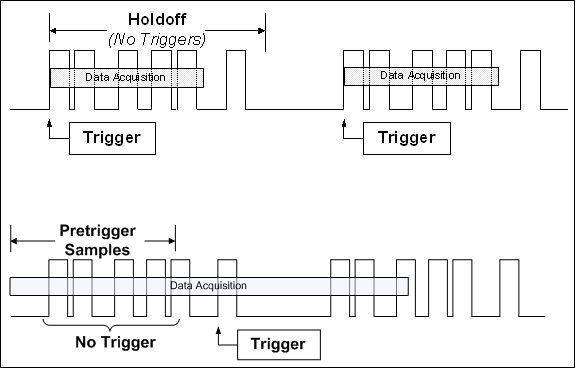IviDigitizer Trigger Sub-System
The trigger sub-system configures the type of event that triggers the digitizer. The global trigger subsystem properties are the following:
IviDigitizer Active Trigger Source
IviDigitizer Pretrigger Samples
The IviDigitizer Active Trigger Source property, a string, specifies which of the available trigger sources to use.
The IviDigitizer Trigger Delay property specifies the position of the first point in the captured waveform record relative to the trigger event. If the trigger delay value is positive, the first point in the waveform record occurs after the trigger event. If the value is negative, the first point in the waveform record occurs before the trigger event. Note that this help file uses the term trigger delay instead of the acquisition start time terminology used by the Iviscope specification. In typical systems, these represent the same quantity.
The IviDigitizer Trigger Holdoff property specifies the length of time after the digitizer detects a trigger during which the digitizer ignores additional triggers. The trigger holdoff property affects the instrument operation only when the digitizer is configured to acquire multiple records, meaning that the Num Records property is greater than 1. If a trigger event occurs while the digitizer is still filling up a record, the event is ignored even if the trigger holdoff property is set to zero. This property is identical to the Trigger Holdoff property in the IviScope interface.
The IviDigitizer Trigger Modifier property specifies the digitizer’s behavior in the absence of the configured trigger. This property is identical to the Trigger Modifier property in the IviScope interface.
The IviDigitizer Pretrigger Samples property is the number of samples needed to fill up the data buffer with pre-trigger data. Use this property to capture as much pre-trigger data as possible without losing important events.
Although you can use the Pretrigger Samples property and the Trigger Holdoff property to obtain similar results, these properties actually perform quite different functions and are used for different applications.
- Trigger Holdoff is measured starting from the time of a trigger event and is specified in units of time (seconds). You can use this property to trigger on a part of a long repeating signal. When the data capture buffer is filled, use the Trigger Holdoff property to prevent the digitizer from triggering again until the sequence repeats itself.
- Pretrigger Samples is used to gather as much pre-trigger data as possible without missing an important event. This property is measured in number of samples and is the minimum number of samples that must be recorded before the digitizer responds to a trigger event. This guarantees that some data is recorded before the trigger event occurs. Counting the pretrigger samples begins when you call the IviDigitizer Initiate Acquisition VI. If you record multiple records, counting the pretrigger samples begins after each prior record is filled and when the digitizer can collect a new data record; that is, at the end of the preceding record plus any re-arm time that the digitizer may require.
Trigger Holdoff and Pretrigger Samples are not equivalent, although they do perform similar functions. The difference lies in subtle timing relationships between these properties and the trigger event. Trigger Holdoff is measured starting from the time of a trigger event, while Pretrigger Samples is measured from the time that the digitizer is ready to capture a new record (the time recording the previous record is finished plus the re-arm time, if any). This means that pretrigger samples timing is always synchronous with the sample clock. Trigger holdoff is not synchronous with the sample clock because the actual trigger event can occur at any time.
The following figure illustrates the relationship between these properties. The upper half of the figure illustrates the behavior of trigger holdoff for an acquisition with num records greater than one. Here, the second (and subsequent) triggers are accepted until the data acquisition is finished and the holdoff period has expired. The lower half illustrates the behavior of pretrigger samples and shows how trigger events are accepted until a sufficient number of samples iscollected in the digitizer’s data buffer.
